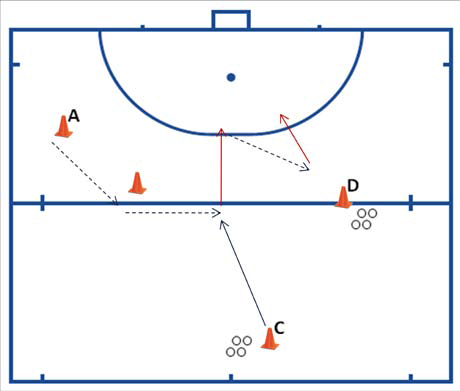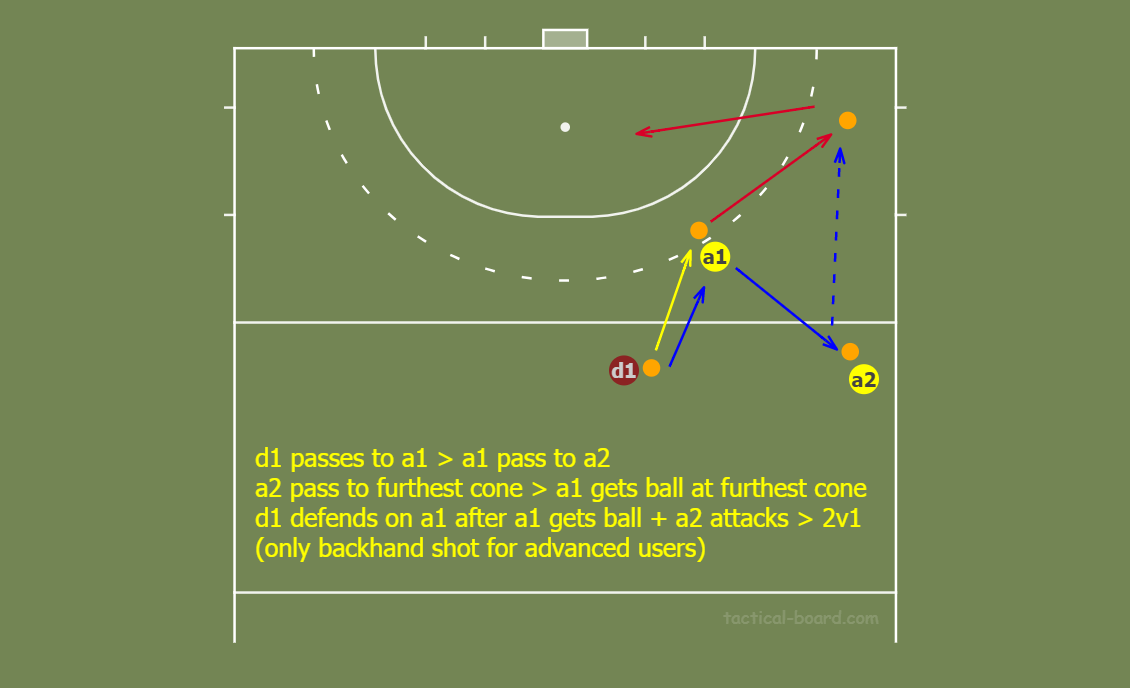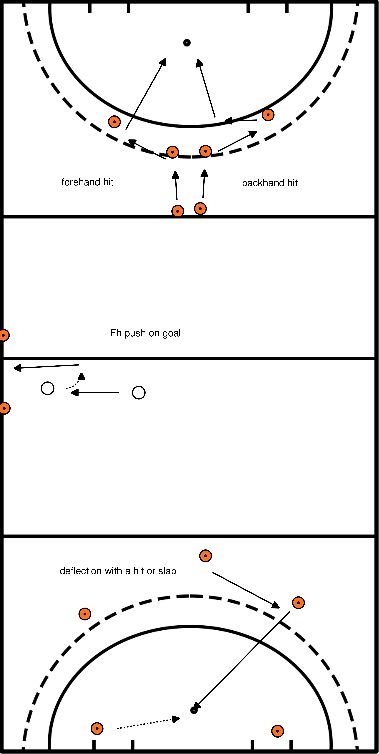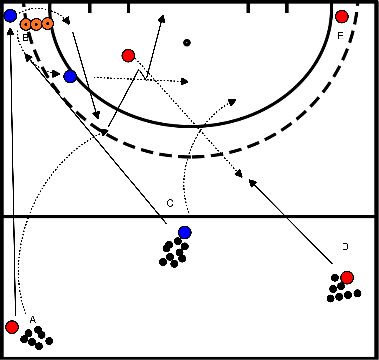Hockey drills for technique hitting
The player with the red pilon is ready for the long corner. This player plays the ball to the left and gives the ball to the player coming from the white pilon. The player of the white pilon plays the ball as hard as possible into the circle (towards the goal).
When the long corner is taken, the players try to run into the blue and orange pilon and intercept the ball. The player who intercepts the ball scores on the back line and the other player scores on the 23-m line. It becomes a 1 to 1.
Swap: Red - White - Blue - Orange - Red
Attention: The player who takes the long corner stands ready as if he himself is going towards the circle. Pass the ball hard and low towards the dot.
- Put out the columns as shown in the figure
- Spread the balls over pylon C and D.
- In this exercise you place a player at pylon C and D.
- The rest of the team will line up at pylon A.
- From A onwards, the player walks around the pylon
- From the post, the player makes a sideways movement facing the ball (facing C).
- Player C plays the ball in the forehand of A
- A takes the ball and turns right open
- A runs in the direction of the circle and finishes at goal.
- From here he runs to D and receives another ball.
- The player turns open to the left and finishes on goal again.


- Each team has 2 goals. (see rules triple hockey).
- 3 against 3 where 5x passes is 1 point (if the ball is intercepted, start counting again).
- possibly 3 against 2 games with 1 player (trainer?)
- always with the attacking team (complicated exercise!)
- Each team has 5 inverted pylons to defend.
- The pylons are on the line and the players may only stand/defend on their own half.
- Which team knocks over the pylons of the other first.

- The children are placed in 2 rows.
- The trainer stands just behind the 2 rows and rolls a ball forward.
- The front 2 players try to conquer the ball.
- The player in possession
- drives the ball towards the goal.
- The other tries to conquer the ball again.
- From a marked point, the ball may not be taken away and the player in possession makes a shot at goal.

- Divide the group in two.
- Everyone stands in his own free space.
- You can score points by dribbling to the pylon and return to the free space, this is 1 point.
- If you get tapped you have to go back, but it doesn't give you a point.
- After 2 minutes the 2 taggers are replaced.
- (first practice without ball and stick)

- defender 1 passes to attacker 1
- attacker 1 to attacker 2
- through pass from attacker 2 to attacker 1
- defender 1 defends on attacker 1 when he has received the through pass
- attacker 2 attacks > 2v1

- Push: In the circle and close to the goal
- slap: for a deflection or from 2 meters inside the circle
- deflection:
- https://www.youtube.com/watch?v=EZ7-bvFhojs
- hit: top of the circle FH/BH
- FH:
- https://www.youtube.com/watch?v=Sgx-pvioXrE
- BH:
- https://www.youtube.com/watch?v=j0PC3GbGRm0

- The exercise is meant to simulate a game.
- It is therefore intended that one team consists of the defenders/defending midfielders and the other team consists of the attackers.
- The attackers can score in the normal goal (decide if they can hit high as in the game).
- The defending side can score by driving the ball.
- Over the line of the goals on the half way line.
- The attackers learn to play over and finish at goal and the defending side learns to defend to the outside.
- A passes deep to B, B goes around behind pilons and gives the ball to A in front, A scores on goal;
- B goes back to position, offers himself and gets the ball from C. CB play a 2v1 against A;
- A enters the ball at D gets ball and plays (D, E and A) a 3v2 against CB.

Game with different variations:
- with grip
- with globe
- with stick in weird position
- with other balls
- Player A runs left towards the pilon straight ahead and retrieves the ball so that the pilon is played out.
- Then player A passes the ball deep on to player B, who runs in.
- Player B puts the ball back to player A
- Player A finishes.
Then player A does the task of player B and vice versa.








